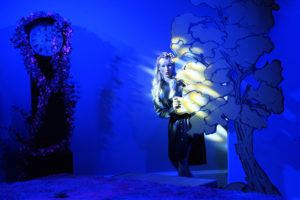
Wexford Festival Opera 2022 Review: The Spectre Knight
Cellier’s Rarely Performed Operetta Is Warmly Received
By Alan Neilson(Photo: Padraig Grant)
Few people will be familiar with the operas of the 19th century British composer Alfred Cellier. Yet during his day, he was well-known for his comic operas, which are very much in the mould of Gilbert & Sullivan, although he never really posed a threat to their dominance.
In 1886, his opera “Dorothy” broke all records with an initial run of 931 performances in London’s West End. Today, however, his operas are rarely, if ever, performed, and although there exist a couple of recordings of his operas, they have done little to rehabilitate his standing, with commentators praising his music, but lamenting the inferior quality of the libretti. He is, therefore, a perfect subject for the attentions of Wexford Festival Opera.
No surprise, therefore, that the festival took the decision to perform his 1878 operetta “The Spectre Knight” as one of its afternoon “pocket operas,” presentations aimed at giving the festival chorus members the opportunity to appear in solo roles.
Written to a libretto by James Albery, the operetta focuses on Viola, who, having been secluded in a magical, remote glen as a baby, has grown up without ever seeing a man, that is, apart from her father, the Grand Duke, and his Lord Chamberlain. All changes, however, when a distant cousin called Otho arrives on the scene. He sets about wooing her by impersonating a ghost, who is said to inhabit the glen.
Obviously, there is plenty of scope for comic shenanigans, which Albery adds to with allusions to characters and scenes from Shakespeare’s plays, such as the ghost from “Hamlet” and Viola from “Twelfth Night.”
O’Neill Hits The Right Note
The spoken dialogue was rewritten by the director, Sinead O’Neill, to bring it line with 21st century humor and sensibilities. Her text was light and amusing, although she rarely strayed from the obvious and relied heavily on innuendo, with plenty of talk about men’s packages. To be fair, however, it did have the audience laughing out loud.
O’Neill wanted her staging to be “bright, zany, madcap,” and along with set and costume designer Lisa Krugel and lighting designer John Comiskey, that is exactly what they achieved. Ensuring that there was plenty of movement on the stage, the characters were encouraged to exaggerate their movements and gestures, with an eye always focused on the underlying humor. There was lots of hiding behind scenery, knowing looks aimed towards the audience, and even an amusing, simple dance. It had the feel of a Christmas pantomime or amateur dramatics.
Krugel’s sets, with the artwork designed by the children of St. Iberius’ school, were simple, functional and colorful, and they captured the enchanting world of a fairytale. The costumes and makeup were designed to add a little extra fun with old-fashioned hats, large eyebrows, long mustaches, and suchlike, as well as a touch of the romantic with feathers and flowers added to the dresses, where appropriate. The colors were largely monochromatic, which created a pleasing contrast with the scenery, while Cominsky’s lighting was used sensitively to alter the coloring and mood.
Cellier’s music is surprisingly inventive in parts, although it was difficult to escape the shadow of Gilbert & Sullivan’s influence while listening to the performance. The music director Gioele Muglialdo successfully accompanied the singers on the piano with an energetic, clear, free-flowing, and at times even bouncy, humorous performance, which included quotations from operas such as “Rigoletto” and “La Traviata.” Moreover, he was happy to join in with the general zaniness, engaging with the singers and audience, donning feathers, and the like.
A Totally Committed Cast
The cast involved themselves thoroughly with the production, combining to produce a lively, well-acted and well-sung performance, both individually and in the numerous ensemble pieces.
Soprano Jennifer Lee was a fresh, naive Viola, who really appeared to have little idea of what love entailed, beyond roses, puppy dogs, and skipping, hand-in-hand with her love through a sunny meadow. She really was sentimentality writ large and, therefore, totally in keeping with the fairytale spirit. She possesses a bright, attractive voice with a versatile coloratura.
Thomas Bennett made a fine impression as the larger-than-life eccentric Duke. He sang with a real swagger, his domineering, resonant, dark-colored bass booming out his lines without a care in the world. In deliberately overegging the role, he added to the general sense of make-believe and fun.
Baritone Matthew Nuttall was a confident Otho-cum-ghost with a strong stage presence. He possesses a resonant, secure voice, which he employed passionately and, appropriately, somewhat tongue-in-cheek, to produce a lyrically attractive presentation.
Tenor Monwabisi Lindi was a laid-back, relaxed Lord Chamberlain who had the measure of the Duke but was happy to go along with his madcap ideas. He displayed a real flair when engaging directly with the audience, and possessed an enthusiasm that was contagious.
The two mezzo-sopranos, Grace Maria Wain as the First Lady and Erin Fflur as the Second Lady, produced one of the operetta’s most memorable numbers when they fell out over Otho and started a musical cat fight as they started hissing at each other, an idea of which Rossini would have been proud.
So, what was there not to like? Well, if you do not care for Gilbert & Sullivan, then “The Spectre Knight” would have left you cold. That much is certain!
On the other hand, if Gilbert & Sullivan is to your taste, then this was a fun way to spend the afternoon. Cellier’s work is colorful, fast-moving, amusing, full of easy-on-the-ear melodies, and has a simple, easy-to-follow plot. Certainly, the audience appreciated it, and gave the performers a standing ovation at the final curtain.



